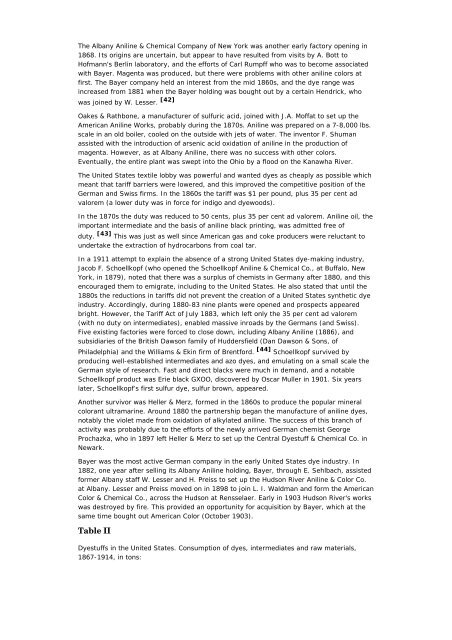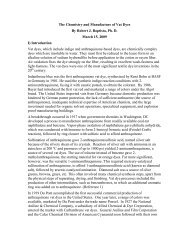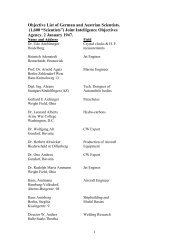International Dyestuff Industry - ColorantsHistory.Org
International Dyestuff Industry - ColorantsHistory.Org
International Dyestuff Industry - ColorantsHistory.Org
You also want an ePaper? Increase the reach of your titles
YUMPU automatically turns print PDFs into web optimized ePapers that Google loves.
The Albany Aniline & Chemical Company of New York was another early factory opening in<br />
1868. Its origins are uncertain, but appear to have resulted from visits by A. Bott to<br />
Hofmann's Berlin laboratory, and the efforts of Carl Rumpff who was to become associated<br />
with Bayer. Magenta was produced, but there were problems with other aniline colors at<br />
first. The Bayer company held an interest from the mid 1860s, and the dye range was<br />
increased from 1881 when the Bayer holding was bought out by a certain Hendrick, who<br />
was joined by W. Lesser. [42]<br />
Oakes & Rathbone, a manufacturer of sulfuric acid, joined with J.A. Moffat to set up the<br />
American Aniline Works, probably during the 1870s. Aniline was prepared on a 7-8,000 lbs.<br />
scale in an old boiler, cooled on the outside with jets of water. The inventor F. Shuman<br />
assisted with the introduction of arsenic acid oxidation of aniline in the production of<br />
magenta. However, as at Albany Aniline, there was no success with other colors.<br />
Eventually, the entire plant was swept into the Ohio by a flood on the Kanawha River.<br />
The United States textile lobby was powerful and wanted dyes as cheaply as possible which<br />
meant that tariff barriers were lowered, and this improved the competitive position of the<br />
German and Swiss firms. In the 1860s the tariff was $1 per pound, plus 35 per cent ad<br />
valorem (a lower duty was in force for indigo and dyewoods).<br />
In the 1870s the duty was reduced to 50 cents, plus 35 per cent ad valorem. Aniline oil, the<br />
important intermediate and the basis of aniline black printing, was admitted free of<br />
duty. [43] This was just as well since American gas and coke producers were reluctant to<br />
undertake the extraction of hydrocarbons from coal tar.<br />
In a 1911 attempt to explain the absence of a strong United States dye-making industry,<br />
Jacob F. Schoellkopf (who opened the Schoellkopf Aniline & Chemical Co., at Buffalo, New<br />
York, in 1879), noted that there was a surplus of chemists in Germany after 1880, and this<br />
encouraged them to emigrate, including to the United States. He also stated that until the<br />
1880s the reductions in tariffs did not prevent the creation of a United States synthetic dye<br />
industry. Accordingly, during 1880-83 nine plants were opened and prospects appeared<br />
bright. However, the Tariff Act of July 1883, which left only the 35 per cent ad valorem<br />
(with no duty on intermediates), enabled massive inroads by the Germans (and Swiss).<br />
Five existing factories were forced to close down, including Albany Aniline (1886), and<br />
subsidiaries of the British Dawson family of Huddersfield (Dan Dawson & Sons, of<br />
Philadelphia) and the Williams & Ekin firm of Brentford. [44] Schoellkopf survived by<br />
producing well-established intermediates and azo dyes, and emulating on a small scale the<br />
German style of research. Fast and direct blacks were much in demand, and a notable<br />
Schoellkopf product was Erie black GXOO, discovered by Oscar Muller in 1901. Six years<br />
later, Schoellkopf’s first sulfur dye, sulfur brown, appeared.<br />
Another survivor was Heller & Merz, formed in the 1860s to produce the popular mineral<br />
colorant ultramarine. Around 1880 the partnership began the manufacture of aniline dyes,<br />
notably the violet made from oxidation of alkylated aniline. The success of this branch of<br />
activity was probably due to the efforts of the newly arrived German chemist George<br />
Prochazka, who in 1897 left Heller & Merz to set up the Central <strong>Dyestuff</strong> & Chemical Co. in<br />
Newark.<br />
Bayer was the most active German company in the early United States dye industry. In<br />
1882, one year after selling its Albany Aniline holding, Bayer, through E. Sehlbach, assisted<br />
former Albany staff W. Lesser and H. Preiss to set up the Hudson River Aniline & Color Co.<br />
at Albany. Lesser and Preiss moved on in 1898 to join L. I. Waldman and form the American<br />
Color & Chemical Co., across the Hudson at Rensselaer. Early in 1903 Hudson River's works<br />
was destroyed by fire. This provided an opportunity for acquisition by Bayer, which at the<br />
same time bought out American Color (October 1903).<br />
Table II<br />
<strong>Dyestuff</strong>s in the United States. Consumption of dyes, intermediates and raw materials,<br />
1867-1914, in tons:





